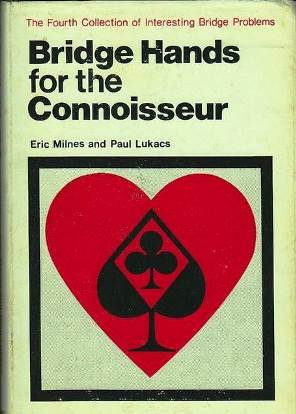
Paul Lukacs (1915–1982) was a Hungarian-born Israeli analyst and composer of problems in the «play of the hand» at contract bridge. Some consider him «the best bridge player ever away from the table», as defined by Victor Mollo. He specialized in single dummy problems. (Wikipedia)
The average bridge problem by no means springs ready-made from the bridge table. Its construction is really more like that of a mathematical problem. First there is a germ of an idea. Then a great deal of thought and imagination, topped by a considerable amount of luck. To illustrate this theme, I will present you with an intricate » surety » play.

Suppose you are playing a spade contract. West leads a heart and from the table you put up the Queen from the Ace-Queen combination without any risk as you have eliminated hearts from your hand. I had corresponded about this idea with my late friend R. Darvas who turned out the following version (Right through the Pack: The tale of the Nine of Diamonds):
The bidding:
| North | South | ||
| 1 |
1 |
||
| 2 |
Pass |
The hand as reported by the nine of diamonds: West led the Queen of trumps. The declarer sagaciously ducked in dummy and East took the trick with the Ace. He led the King of clubs and West, void in the suit, discarded a small diamond. West discarded another small diamond on East’s ![]() A and then ruffed the third round of clubs with the deuce. West led the knave of trumps and dummy’s King made, East discarding a small diamond.
A and then ruffed the third round of clubs with the deuce. West led the knave of trumps and dummy’s King made, East discarding a small diamond.
The declarer played the knave of Clubs from dummy and discarded the nine of diamonds from his hand. West rightly declined to ruff, so dummy’s last trump was led. West’s ten took it and lie returned a diamond. The queen was finessed successfully and two hearts were discarded on the Queen and Ace of dia-monds. The contract was thus made. As West had no more spades or clubs his only other return would have been a heart up to South’s KJ and again the contract would have been made.»
Thus the defence was punished for not leading a diamond earlier and so forcing South to choose between the heart and diamond finesses. This hand is without doubt ingenious. Nevertheless I wanted to reconstruct the same theme in a more’ streamlined version and I chanced upon the following set-up:
Against South’s Six Spades contract West leads ![]() Q and East shows out. See how clear wanted to make the basic idea.
Q and East shows out. See how clear wanted to make the basic idea.
One cashes the Ace, King of spades, the Ace, King of diamonds (discarding a club), the Ace of clubs, afterwards ruffs a diamond and throws in West with a trump. So far so good, but I simply overlooked that by eliminating both diamonds and clubs you have almost a 100 percent safety.
Still I did not give up. Making a small change (and what a lucky one) I arrived at the following hands:
The’ same contract, lead and honor distribution as before. See what a miraculous effect was worked by this slight change. The first trick is taken by the Ace of spades (East shows out). Now we cash the Ace of diamonds (!!) and assume that West follows suit (we shall handle later the case when he shows out). The next trick goes to the ![]() A and a small club is led towards
A and a small club is led towards ![]() A. By the way we note that the first four tricks were taken by the four Aces. We cash
A. By the way we note that the first four tricks were taken by the four Aces. We cash ![]() K and play a club towards the King. On
K and play a club towards the King. On ![]() K the last club will be discarded and next we concede a trump trick to West.
K the last club will be discarded and next we concede a trump trick to West.
A heart, diamond or the queen of clubs return immediately gives us the twelfth trick. If West returns a small club we cover it with the Jack and if it does not hold the trick North’s last club becomes master. Now let us return to the devilish distribution when West ruffs the first diamond and returns a spade (» best » as the problemists use to say).
This gives us quite a bit of information: East held originally ten diamonds. Let us try to find out his remaining three cards. We cash ![]() A on which he follows suit, else the disclosed club finesse solves our problem. Next we cash
A on which he follows suit, else the disclosed club finesse solves our problem. Next we cash ![]() A and hope that East will show out because then the clubs divide 3-3 (as East has ten diamonds and three clubs) and the fourth club can be established. East follows a heart and we already know twelve of East’s cards. What is his thirteenth one?
A and hope that East will show out because then the clubs divide 3-3 (as East has ten diamonds and three clubs) and the fourth club can be established. East follows a heart and we already know twelve of East’s cards. What is his thirteenth one?
Let us go on with our investigation and cash the King of hearts. If East plays another heart we’ know that he had only a single club and so the club finesse becomes obvious. So—always an unlucky player—East
doesn’t follow the second heart lead. So we brilliantly conclude—by the law of the excluded middle —that East held originally a doubleton club. We still are in the dark about the location of the Queen of clubs but now it matters very little. We enter the table with a spade, cash ![]() K and all of our remaining trumps producing the following two-card end position:
K and all of our remaining trumps producing the following two-card end position:
West must keep his Queen of hearts, so he remains with only one club. East, as we know, held originally two clubs, so after cashing the King of clubs the Jack will be master. The hand is really unique: after the lead of the Queen of spades you can claim at least twelve tricks. If every card lies as badly as it can, then we drop the Queen of clubs at the twelfth trick.
